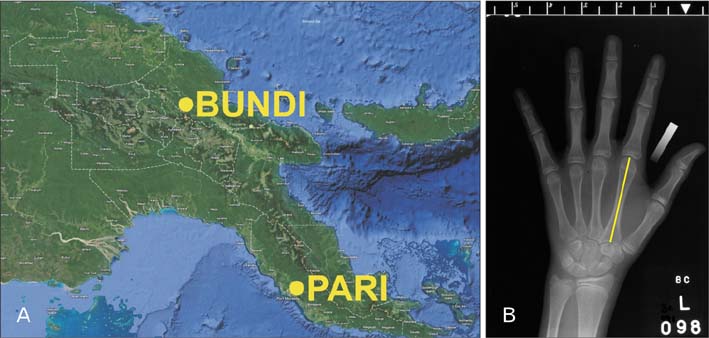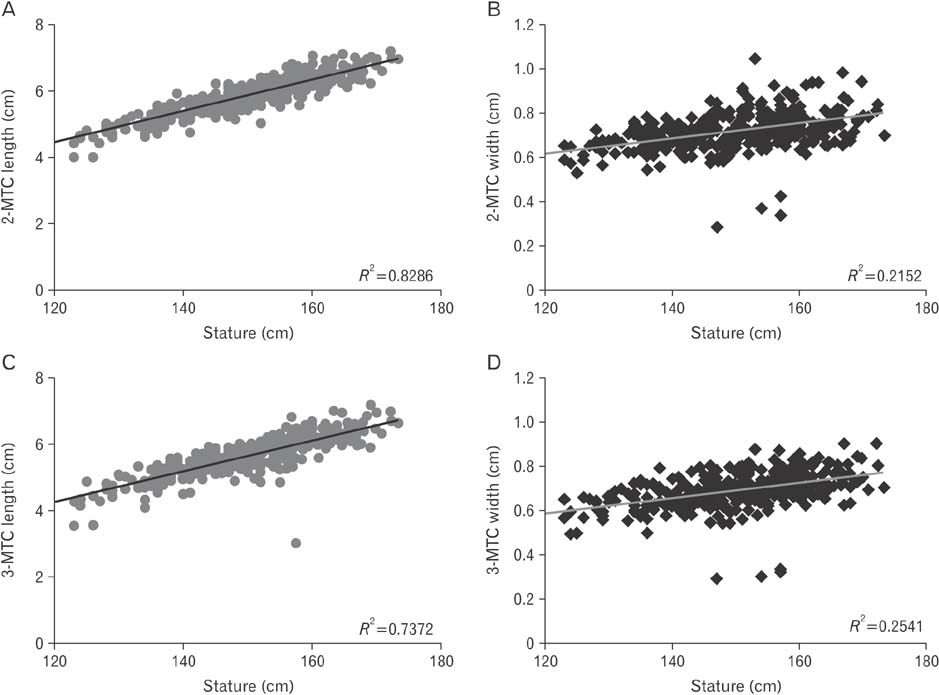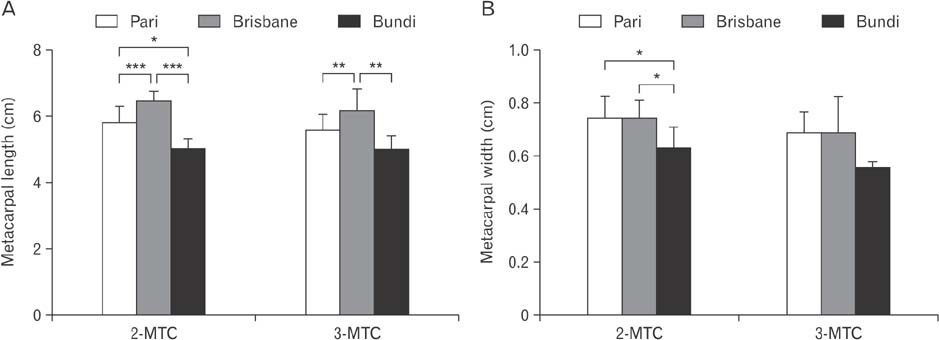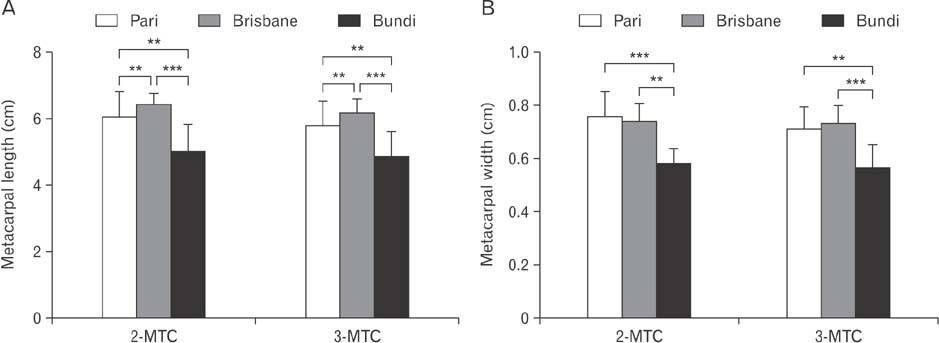Anat Cell Biol.
2018 Mar;51(1):31-40. 10.5115/acb.2018.51.1.31.
Nutrition and growth: assessing the impact of regional nutritional intake on childhood development and metacarpal parameters
- Affiliations
-
- 1Faculty of Health Sciences and Medicine, Bond University, Gold Coast, Australia. cmoro@bond.edu.au
- KMID: 2418393
- DOI: http://doi.org/10.5115/acb.2018.51.1.31
Abstract
- Measuring skeletal development throughout juvenile growth can provide a greater understanding into the health, hormonal function and genetics of children. The metacarpals have been of interest for their potential to provide insights into healthy juvenile skeletal development. This study investigated the growth patterns of developing females from isolated communities who had varied diets. Anthropometrical measurements and hand-wrist X-rays were taken of 353 juvenile females from three populations: Pari Coastal Village and Bundi Highlands Village, Papua New Guinea (PNG); and Brisbane, Australia between 1968 to 1983. Radiographs were digitized, and the length and width of the second and third metacarpals compared to each subject's height and weight. As subject heights increased, metacarpal length and width increased. However, stature and second metacarpal length indicated the strongest correlation (P < 0.01), compared to third metacarpal length (P < 0.01) or width. From 11 to 13 years of age, Brisbane subjects were significantly heavier and taller in comparison to subjects from PNG, and coastal females were heavier and taller than the highland females. A prominent difference between the two PNG populations was the regional intake of protein in their diets. The second metacarpal presents particularly accurate measurements when determining the height or development of a child. Nutritional intake appears to have a major influence normal childhood growth, with a potential for protein deficiency to strongly inhibit growth. Any delayed growth is particularly evident in the child's stature, as well as in the development of the metacarpal long bones of the hand.
Keyword
MeSH Terms
Figure
Cited by 1 articles
-
Stature estimation using the sternum in a Thai population
Verapat Jeamamornrat, Tawachai Monum, Waratchaya Keereewan, Pasuk Mahakkanukrauh
Anat Cell Biol. 2022;55(2):170-178. doi: 10.5115/acb.22.045.
Reference
-
1. Ahmad A, Komai S. Malnutrition and neurologic problems among children in the developing world. Semin Pediatr Neurol. 2015; 22:73–74.
Article2. Ndiaye B, Lemonnier D, Sall MG, Prudhon C, Diaham B, Zeghoud F, Guillozo H, Leite N, Wade S. Serum osteocalcin regulation in protein-energy malnourished children. Pediatr Res. 1995; 37:606–610.
Article3. Branca F, Robins SP, Ferro-Luzzi A, Golden MH. Bone turnover in malnourished children. Lancet. 1992; 340:1493–1496.
Article4. Trotter M, Gleser GC. Estimation of stature from long bones of American Whites and Negroes. Am J Phys Anthropol. 1952; 10:463–514.
Article5. Meadows L, Jantz RL. Allometric secular change in the long bones from the 1800s to the present. J Forensic Sci. 1995; 40:762–767.
Article6. Telkka A. On the prediction of human stature from the long bones. Acta Anat (Basel). 1950; 9:103–117.7. Ruff C. Variation in human body size and shape. Annu Rev Anthropol. 2002; 31:211–232.
Article8. Silventoinen K, Kaprio J, Lahelma E, Koskenvuo M. Relative effect of genetic and environmental factors on body height: differences across birth cohorts among Finnish men and women. Am J Public Health. 2000; 90:627–630.
Article9. Silva LM, van Rossem L, Jansen PW, Hokken-Koelega AC, Moll HA, Hofman A, Mackenbach JP, Jaddoe VW, Raat H. Children of low socioeconomic status show accelerated linear growth in early childhood: results from the Generation R Study. PLoS One. 2012; 7:e37356.
Article10. Bonjour JP, Gueguen L, Palacios C, Shearer MJ, Weaver CM. Minerals and vitamins in bone health: the potential value of dietary enhancement. Br J Nutr. 2009; 101:1581–1596.
Article11. Shamir R, Turck D, Phillip M. Nutrition and growth. Basel: Karger;2013.12. Kim W, Bae S, Kim H, Kim Y, Choi J, Lim SY, Lee HJ, Lee J, Choi J, Jang M, Lee KE, Chung SG, Hwang YI, Kang JS, Lee WJ. Ascorbic acid insufficiency induces the severe defect on bone formation via the down-regulation of osteocalcin production. Anat Cell Biol. 2013; 46:254–261.
Article13. Willing MC, Torner JC, Burns TL, Janz KF, Marshall T, Gilmore J, Deschenes SP, Warren JJ, Levy SM. Gene polymorphisms, bone mineral density and bone mineral content in young children: the Iowa Bone Development Study. Osteoporos Int. 2003; 14:650–658.
Article14. Hediger ML, England LJ, Molloy CA, Yu KF, Manning-Courtney P, Mills JL. Reduced bone cortical thickness in boys with autism or autism spectrum disorder. J Autism Dev Disord. 2008; 38:848–856.
Article15. Abrahamyan DO, Gazarian A, Braillon PM. Estimation of stature and length of limb segments in children and adolescents from whole-body dual-energy X-ray absorptiometry scans. Pediatr Radiol. 2008; 38:311–315.
Article16. Gryfe CI, Exton-Smith AN, Payne PR, Wheeler EF. Pattern of development of bone in childhood and adolescence. Lancet. 1971; 1:523–526.
Article17. Himes JH, Yarbrough C, Martorell R. Estimation of stature in children from radiographically determined metacarpal length. J Forensic Sci. 1977; 22:452–455.
Article18. Karaman AG, Teke HY, Günay I, Doğan B, Bilge Y. Height estimation using anthropometric measurements on X-rays of wrist and metacarpal bones. Internet J Biol Anthropol. 2008; 2:1.
Article19. Moro C, Štromberga Z, Raikos A, Stirling A. The effectiveness of virtual and augmented reality in health sciences and medical anatomy. Anat Sci Educ. 2017; 10:549–559.
Article20. Malcolm LA. Growth and development in New Guinea: a study of the Bundi people of the Madang district. Madang: Institute of Human Biology of Papua and New Guinea;1970.21. Maddocks I. Pari Hanua : an appreciation of the traditional, colonial and modern life of a Papuan village, inspired by 50 years of contact and 6 years of residence. Papua New Guinea: University of Papua New Guinea Press and Bookshop;2012.22. White TD, Black MT, Folkens PA. Human osteology. 3rd ed. Burlington, MA: Elsevier Science;2011.23. Haiter-Neto F, Kurita LM, Menezes AV, Casanova MS. Skeletal age assessment: a comparison of 3 methods. Am J Orthod Dentofacial Orthop. 2006; 130:435.e15–435.e20.
Article24. Schneider CA, Rasband WS, Eliceiri KW. NIH Image to ImageJ: 25 years of image analysis. Nat Methods. 2012; 9:671–675.
Article25. Abdel-Malek AK, Ahmed AM, el-Sharkawi SA, el-Hamid NA. Prediction of stature from hand measurements. Forensic Sci Int. 1990; 46:181–187.
Article26. Allbrook D. The estimation of stature in British and East African males: based on tibial and ulnar bone lengths. J Forensic Med. 1961; 8:15–28.27. Genoves S. Proportionality of the long bones and their relation to stature among Mesoamericans. Am J Phys Anthropol. 1967; 26:67–77.28. Macgregor S, Cornes BK, Martin NG, Visscher PM. Bias, precision and heritability of self-reported and clinically measured height in Australian twins. Hum Genet. 2006; 120:571–580.
Article29. Perola M, Sammalisto S, Hiekkalinna T, Martin NG, Visscher PM, Montgomery GW, Benyamin B, Harris JR, Boomsma D, Willemsen G, Hottenga JJ, Christensen K, Kyvik KO, Sørensen TI, Pedersen NL, Magnusson PK, Spector TD, Widen E, Silventoinen K, Kaprio J, Palotie A, Peltonen L. GenomEUtwin Project. Combined genome scans for body stature in 6,602 European twins: evidence for common Caucasian loci. PLoS Genet. 2007; 3:e97.
Article30. Silventoinen K, Sammalisto S, Perola M, Boomsma DI, Cornes BK, Davis C, Dunkel L, De Lange M, Harris JR, Hjelmborg JV, Luciano M, Martin NG, Mortensen J, Nisticò L, Pedersen NL, Skytthe A, Spector TD, Stazi MA, Willemsen G, Kaprio J. Heritability of adult body height: a comparative study of twin cohorts in eight countries. Twin Res. 2003; 6:399–408.
Article31. McEvoy BP, Visscher PM. Genetics of human height. Econ Hum Biol. 2009; 7:294–306.
Article32. Delemarre-van de Waal HA. Environmental factors influencing growth and pubertal development. Environ Health Perspect. 1993; 101:Suppl 2. 39–44.33. Wilcox AJ. On the importance-and the unimportance-of birth-weight. Int J Epidemiol. 2001; 30:1233–1241.34. Tanner JM. Growth as a measure of the nutritional and hygienic status of a population. Horm Res. 1992; 38:Suppl 1. 106–115.
Article35. Davey Smith G, Hart C, Upton M, Hole D, Gillis C, Watt G, Hawthorne V. Height and risk of death among men and women: aetiological implications of associations with cardiorespiratory disease and cancer mortality. J Epidemiol Community Health. 2000; 54:97–103.36. Gunnell D, Okasha M, Smith GD, Oliver SE, Sandhu J, Holly JM. Height, leg length, and cancer risk: a systematic review. Epidemiol Rev. 2001; 23:313–342.
Article37. Jousilahti P, Tuomilehto J, Vartiainen E, Eriksson J, Puska P. Relation of adult height to cause-specific and total mortality: a prospective follow-up study of 31,199 middle-aged men and women in Finland. Am J Epidemiol. 2000; 151:1112–1120.38. Langenberg C, Shipley MJ, Batty GD, Marmot MG. Adult socioeconomic position and the association between height and coronary heart disease mortality: findings from 33 years of follow-up in the Whitehall Study. Am J Public Health. 2005; 95:628–632.
Article39. Lawlor DA, Ebrahim S, Davey Smith G. The association between components of adult height and Type II diabetes and insulin resistance: British Women's Heart and Health Study. Diabetologia. 2002; 45:1097–1106.
Article40. Lawlor DA, Taylor M, Davey Smith G, Gunnell D, Ebrahim S. Associations of components of adult height with coronary heart disease in postmenopausal women: the British women's heart and health study. Heart. 2004; 90:745–749.
Article41. Tanner JM, Davies PS. Clinical longitudinal standards for height and height velocity for North American children. J Pediatr. 1985; 107:317–329.
Article42. Victora CG, Adair L, Fall C, Hallal PC, Martorell R, Richter L, Sachdev HS. Maternal and Child Undernutrition. Maternal and child undernutrition: consequences for adult health and human capital. Lancet. 2008; 371:340–357.
Article43. Black RE, Allen LH, Bhutta ZA, Caulfield LE, de Onis M, Ezzati M, Mathers C, Rivera J. Maternal and Child Undernutrition Study Group. Maternal and child undernutrition: global and regional exposures and health consequences. Lancet. 2008; 371:243–260.
Article44. Sinno D, Charafeddine L, Mikati M. Enhancing early child development: a handbook for clinicians. New York: Springer New York;2012.45. Grantham-McGregor SM, Powell CA, Walker SP, Himes JH. Nutritional supplementation, psychosocial stimulation, and mental development of stunted children: the Jamaican Study. Lancet. 1991; 338:1–5.
Article46. Godfrey K, Robinson S, Barker DJ, Osmond C, Cox V. Maternal nutrition in early and late pregnancy in relation to placental and fetal growth. BMJ. 1996; 312:410–414.
Article47. Brantsæter AL, Birgisdottir BE, Meltzer HM, Kvalem HE, Alexander J, Magnus P, Haugen M. Maternal seafood consumption and infant birth weight, length and head circumference in the Norwegian Mother and Child Cohort Study. Br J Nutr. 2012; 107:436–444.
Article48. Leonard WR. Nutritional determinants of high-altitude growth in Nunoa, Peru. Am J Phys Anthropol. 1989; 80:341–352.
- Full Text Links
- Actions
-
Cited
- CITED
-
- Close
- Share
- Similar articles
-
- Nutritional Management of Failure to Thrive
- The Importance of Nutritional Assessment and Dietary Counseling in Infants and Young Children with Common Illnesses
- Review on Revised Nutrition Guidelines of the Korea National Health Screening Program for Infants and Children
- Enteral Nutrition in Pediatric Patients
- Comparison of the growth and nutritional status of low birth weight and normal birth weight children







